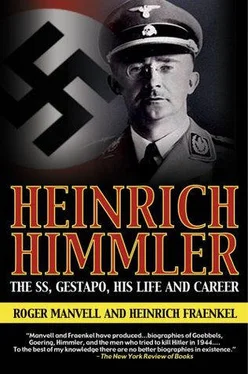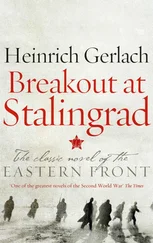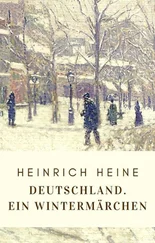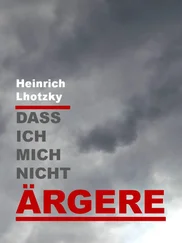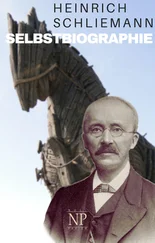Himmler’s need to rid himself of the Jews became an obsession. The ghosts of those still living haunted him more than the ghosts of those now dead; there were Jews everywhere around him, in the north, in the west, in the south, in the areas where his power to reach them was at its weakest. Only in the east was he strong, where his gas chambers were strained to their limits and his ovens choked with the dead. On a visit paid by Himmler in October 1941 to Ohlendorf’s Action Group headquarters in Nikolaeiev he was accompanied by Quisling’s Chief of Police from Norway, and he made use of this visit to reprimand Ohlendorf for sparing the Jews of the local agricultural areas; he was also very concerned about the number of Jews who escaped from the region of Odessa and infiltrated themselves among the Rumanian Jews, many of whom were deported by the Rumanians themselves to a small Jewish reserve in the Transdniestra region in former Russian territory, which by agreement with Germany had been allocated to her Rumanian allies. Many of these Jews managed to survive the war, and German relations with Rumania were in any case to be the cause of dispute between Himmler and Ribbentrop. 13
Rumania’s Jewish population was one of the largest in Europe, amounting before her territory was readjusted to 750,000, and the record of her treatment of them before and during the period of political unrest and civil war preceding the German intervention in the country is as terrible as that of the Nazis themselves, whose Action Groups took over where the Rumanians themselves left off in the areas of Bukovina and Bessarabia, which were in 1940 ceded back to Rumania by Russia. But the small population of Jews in their pocket of Transdniestrian territory became the subject of a fearful bargaining which went on throughout the rest of the war, and involved in the end the World Jewish Congress, the Swiss Red Cross, the British (as the chilly custodians of Palestine) and the obstructive American State Department. All became involved in the greed of Antonescu and the tactics of Eichmann, who disapproved of the whole tenor of such proceedings, which in his view only compromised the ‘cleanliness’ of the ‘final solution’.
In Bulgaria Himmler was also thwarted; the Jews, though persecuted and deprived of their property, were never deported, and even in Slovakia, after a period of large-scale deportations, the puppet government managed to halt them between July 1942 and September 1944, when the Germans themselves briefly resumed the exodus. During this period, as we have seen, the negotiations for the sale of Jews by Wisliceny and Himmler were still being conducted not only for this territory but for Hungary as well, where Eichmann was to emerge in 1944 from his shell of anonymity and live a high life in Budapest with his horses and his mistress, while supervising the deportation of some 380,000 Jews under the code name Action Hoess. Reitlinger estimates Hoess gassed over 250,000 Hungarian Jews in Auschwitz during the summer of 1944, though Hoess himself boasted the number was 400,000.
Meanwhile, Himmler had not been inactive in the north and west. In July 1942, at the height of the war, he paid a personal visit to Finland to try to enforce the deportation of more Jews. At the same time he visited Reval in Estonia, and from there sent a firm directive to Berger, his liaison officer at Rosenberg’s ministry controlling affairs in the eastern territories, in order to stop the publication of a decree which would give the ultimate authority to decide who was and who was not a Jew to Rosenberg’s Commissar-General and not to Himmler’s Security Police. Himmler wrote to Berger: ‘Do not publish the decree defining Jews. Such foolish precision ties our hands. The Eastern Territories will be freed of all Jews. I alone am responsible to the Führer and do not want any discussion.’
In the west Himmler’s powers were far weaker; the principal German authority in France remained the Wehrmacht , through which the deportation of Jews had to be ordered. Although Jewish refugees rounded up in France were sent east, according to Reitlinger little more than one-sixth of the Jews with French nationality were deported during the years of occupation, though their persecution by other means was as intensive as Himmler’s, Heydrich’s and Eichmann’s agents could make it, particularly during the period of the round-up of 1942, which was undertaken nominally as reprisals for attacks on German soldiers. When the Germans occupied the Free Zone in November 1942, negotiations for handling the Jewish question had to be undertaken with the Italians, into whose area in the South of France the Jews poured from the north, and Eichmann’s attempts to secure them ended in almost total failure.
In Holland, Himmler’s deportation orders worked more smoothly and almost three-quarters of the Jewish population were removed. On a report sent him by the S.S. Chief, Hans Rauter, about his deportation measures in September 1943, Himmler was able to scribble an approving Sehr gut. In Belgium, the impact of the S.S. was considerably lessened by the opposition to their extremism shown by General von Falkenhausen, the German Military Governor until his arrest in July 1944. In Denmark, Himmler’s anti-Jewish pressures were resisted with almost entire success; he attempted during 1943 to make Werner Best, formerly on Heydrich’s staff, then in Paris and now Reich Plenipotentiary in Denmark, understand that the ‘final solution’ applied equally to Jews in the semi-neutral territory of Denmark as to those in the east. His persuasion, however, did not reach the point of action until the period in August 1943 when martial law had to be proclaimed following riots in the docks of Odense, action by the resistance movement in Copenhagen and the revolt of the small Danish fleet. Himmler, who had by this time become Minister of the Interior, used this unrest to insist throngh Ribbentrop that Best start at once to seize the Danish Jews and deport them to the east. There then followed the usual unseemly evasions of responsibility in which so many administrators became expert during the latter years of the war, when the possibilities of defeat and future reprisals began increasingly to influence their actions; the round-up of Jews became, in effect, a token affair that provided ample opportunities for saving Jewish life in a country which did everything it could to protect the Jews or evacuate them to Sweden. Himmler was finally persuaded that Denmark was ‘Jew-free’ only after Best had done everything he could to encourage the Jews to escape. In Norway, where conditions were far less favourable for diplomatic hedging than in Denmark, two-thirds of the small Jewish population managed to elude Himmler, many escaping over the border into Sweden.
The main resistance to Himmler’s obsessions occurred in the south, for the Italians were never won over to anti-Semitism; in any case there were barely 50,000 Jews living in Italy. The Italians had refused to co-operate in the South of France, and Eichmann was forced to complain once more of their ‘sabotage’ in Greece and Yugoslavia. Although Mussolini had created his own anti-Jewish laws in 1938 under the influence of Hitler, he did not want to become implicated in genocide. Himmler, as we have seen, was regarded by Hitler as a suitable envoy to negotiate with Mussolini, and he paid several state visits to the Duce, the last being in October 1942, of which no record survives that includes discussion of Jewish deportation. 14Only when the Germans occupied Italy in September 1943 did Himmler gain direct access to those Jews who, having taken refuge in Rome, failed to escape the successive round-ups that followed in the capital and the north. In Yugoslavia and Greece, the proportion of Jewish losses by deportation were, in sharp contrast to Italy, extremely heavy.
Читать дальше
